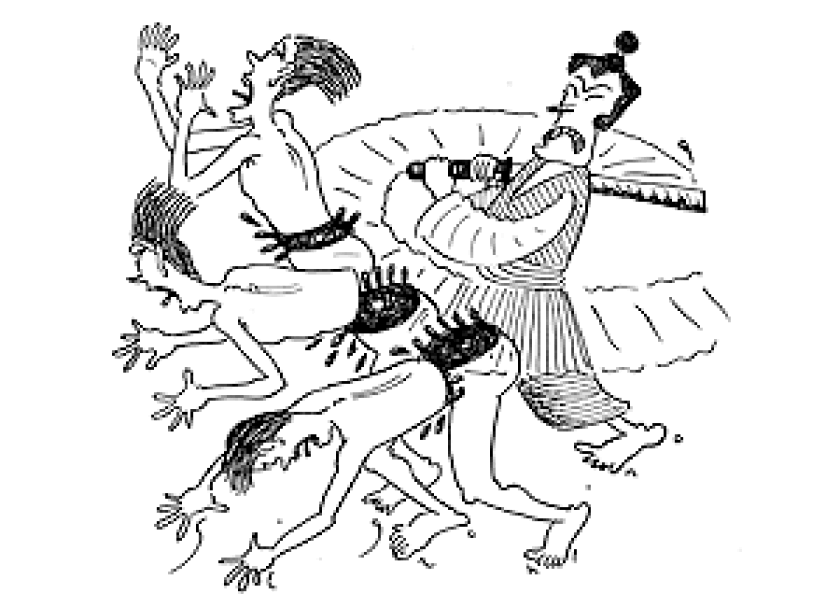Dear Cecil: Samurai swords are reputed to be among the best ever produced, a fact attested to by the practice of testing the swords on human cadavers, usually those of condemned criminals. My question is, just how sharp were these blades? I’ve read accounts declaring certain swords could cut through the hip bones of three grown men set side by side. In my opinion, that’s sharp — maybe too sharp to believe. Where human-cleaving blades are concerned, did any other culture come close technologically (Toledo and Damascus come to mind), or were the Japanese truly at the head of the field? Mr Slick
Cecil replies:
At first I thought this would be the perfect opportunity for a demonstration of Straight Dope home science. However, on investigating the available resources, I discovered we lacked (a) a samurai sword and (b) three volunteers. So we’re back to shoe leather, the Internet, and spies.
First things first. Could historical swords cut clear through somebody? We’re fairly sure at least some samurai swords — katana, they’re called — were tested on the bodies of convicted criminals as part of the practice of tameshigiri, or test cutting. One Japanese sword made in 1662 is inscribed “Two persons completely cut into two pieces (one stroke),” a scholarly article informs us, and reportedly blades bearing five-body ratings can be found in Japanese museums. I’m skeptical — honestly now, five? — but in any case remember we’re talking about stationary, unarmored targets. Remains found at old Japanese battle sites don’t suggest that combatants were routinely cut in two. Furthermore, while we lack adequate comparative data on how many human bodies a good modern sword can slice through, a perusal of the photos in trauma journals indicates a common knife can make surprisingly deep cuts. So don’t get an exaggerated idea of the inherent lethality of Japanese swords.
For more we turn to the Association for Renaissance Martial Arts, which goes the extra mile in testing modern-day swords. These guys have a section on their Web site (http://thearma.org/) where you can watch footage of folks cutting through bamboo poles, pieces of armor, and hunks of dead animal. We contacted ARMA director John Clements, who told us the group has experimented with “accurate replicas of medieval and Renaissance European war swords on freshly culled deer carcasses and pig carcasses and seen first hand that these weapons easily shear and cleave through flesh and bone with basic cutting blows.” He said historical swords used in combat weren’t necessarily as sharp as many assume: “There are videos on our website of fairly blunt blades achieving the same effects as notoriously sharp samurai katana. So, edge sharpness [alone] is not nearly as important as a hard and well-honed edge hitting forcefully with the correct geometry and energy.”
Now to your other question: Did smiths in other locales produce swords as technologically advanced as the celebrated Japanese blades? Comparisons are tough. For one thing, different swords were made for different purposes. The light, wieldy katana was effective against the lacquered leather armor commonly worn in Japan, but would have been less so against European plate-steel armor, which demanded a heavier blade. In addition, we’re still not certain how some historical swords were made. The technology behind the katana is reasonably well understood and, no question, involved some cunning metalwork. One trick was repeatedly folding over and hammering out the hot blade, producing steel with thousands of layers in which the all-important carbon alloy was uniformly distributed; another was fusing a cutting edge of hardened steel to a softer spine. Result: a blade of exceptional strength, flexibility, and sharpness.
By contrast the secrets of the Damascus-steel swords favored by Islamic armies were largely lost and remain conjectural. One study claims Damascus steel contained carbon nanotubes — superstrong cylindrical molecules — that helped give the swords their remarkable flexibility. Another researcher believes naturally occurring trace elements such as vanadium may have been essential constituents of the famed “wootz” steel used by Damascus smiths, and that the exhaustion of the ore source led to the demise of their art.
Let’s not get goofy about this. Today we have an incredible variety of materials and techniques that can produce blades surely rivaling or surpassing the best of olden times. Still, you hear stories of metallurgical know-how lost, some of them quite recent, that give you pause. Twentieth-century Nebraska cutler Frank Richtig, for instance, was famous in certain circles for producing blades that could be driven through steel stock and still retain their sharpness. After painstaking analysis, a couple of Lawrence Livermore scientists think they’ve figured out how he did it (Wadsworth and Lesuer, Materials Characterization, 2000) — no thanks to Richtig, who took his method with him to the grave in the 1970s. “A man is entitled to some secrets,” he said, “and that’s mine.”
Cecil Adams
Send questions to Cecil via cecil@straightdope.com.
